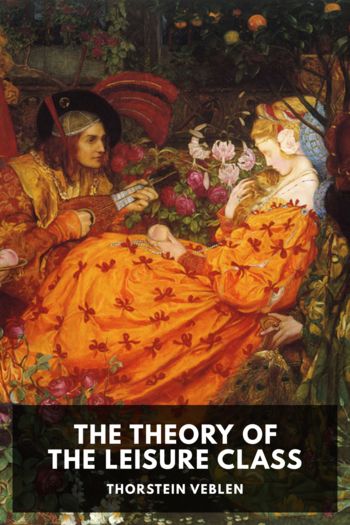The Theory of the Leisure Class by Thorstein Veblen (phonics readers TXT) 📕

- Author: Thorstein Veblen
Book online «The Theory of the Leisure Class by Thorstein Veblen (phonics readers TXT) 📕». Author Thorstein Veblen
It will in place, by way of illustration, to show in some detail how the economic principles so far set forth apply to everyday facts in some one direction of the life process. For this purpose no line of consumption affords a more apt illustration than expenditure on dress. It is especially the rule of the conspicuous waste of goods that finds expression in dress, although the other, related principles of pecuniary repute are also exemplified in the same contrivances. Other methods of putting one’s pecuniary standing in evidence serve their end effectually, and other methods are in vogue always and everywhere; but expenditure on dress has this advantage over most other methods, that our apparel is always in evidence and affords an indication of our pecuniary standing to all observers at the first glance. It is also true that admitted expenditure for display is more obviously present, and is, perhaps, more universally practiced in the matter of dress than in any other line of consumption. No one finds difficulty in assenting to the commonplace that the greater part of the expenditure incurred by all classes for apparel is incurred for the sake of a respectable appearance rather than for the protection of the person. And probably at no other point is the sense of shabbiness so keenly felt as it is if we fall short of the standard set by social usage in this matter of dress. It is true of dress in even a higher degree than of most other items of consumption, that people will undergo a very considerable degree of privation in the comforts or the necessaries of life in order to afford what is considered a decent amount of wasteful consumption; so that it is by no means an uncommon occurrence, in an inclement climate, for people to go ill clad in order to appear well dressed. And the commercial value of the goods used for clothing in any modern community is made up to a much larger extent of the fashionableness, the reputability of the goods than of the mechanical service which they render in clothing the person of the wearer. The need of dress is eminently a “higher” or spiritual need.
This spiritual need of dress is not wholly, nor even chiefly, a naive propensity for display of expenditure. The law of conspicuous waste guides consumption in apparel, as in other things, chiefly at the second remove, by shaping the canons of taste and decency. In the common run of cases the conscious motive of the wearer or purchaser of conspicuously wasteful apparel is the need of conforming to established usage, and of living up to the accredited standard of taste and reputability. It is not only that one must be guided by the code of proprieties in dress in order to avoid the mortification that comes of unfavorable notice and comment, though that motive in itself counts for a great deal; but besides that, the requirement of expensiveness is so ingrained into our habits of thought in matters of dress that any other than expensive apparel is instinctively odious to us. Without reflection or analysis, we feel that what is inexpensive is unworthy. “A cheap coat makes a cheap man.” “Cheap and nasty” is recognized to hold true in dress with even less mitigation than in other lines of consumption. On the ground both of taste and of serviceability, an inexpensive article of apparel is held to be inferior, under the maxim “cheap and nasty.” We find things beautiful, as well as serviceable, somewhat in proportion as they are costly. With few and inconsequential exceptions, we all find a costly hand-wrought article of apparel much preferable, in point of beauty and of serviceability, to a less expensive imitation of it, however cleverly the spurious article may imitate the costly original; and what offends our sensibilities in the spurious article is not that it falls short in form or color, or, indeed, in visual effect in any way. The offensive object may be so close an imitation as to defy any but the closest scrutiny; and yet so soon as the counterfeit is detected, its aesthetic value, and its commercial value as well, declines precipitately. Not only that, but it may be asserted with but small risk of contradiction that the aesthetic value of a detected counterfeit in dress declines somewhat in the same proportion as the counterfeit is cheaper than its original. It loses caste aesthetically because it falls to a lower pecuniary grade.
But the function of dress as an evidence of ability to pay does not end with simply showing that the wearer consumes valuable goods in excess of what is required for physical comfort. Simple conspicuous waste of goods is effective and gratifying as far as it goes; it is good prima





Comments (0)